The cultural and creative sectors are a key driver of global growth and an essential component of smart cities. Culture impact bonds could put them on a secure footing.
At Deloitte Luxembourg, for the last 15 years, we have been analysing the macro trends transforming the art and cultural sectors and the potential opportunities for the wealth management sector. We leverage our industry knowledge of the art and finance ecosystem into a range of services to assist wealth management, visual art and cultural stakeholders worldwide.
In 2011, we unveiled the inaugural Art & Finance report, exploring the business opportunities of incorporating art into wealth management service offerings. In 2019, with the sixth edition of the Art & Finance report, we started exploring the topic of impact investment and culture – with one of the articles, ‘Reimagine: Supporting the arts’, contributed by Fran Sanderson, Director of Arts Programmes and Investments at Nesta. One year later, during our 13th Art & Finance conference, we held two panels on culture and smart cities and on culture and sustainable impact investment, in which Laura Callanan, founding partner of Upstart Co-Lab, took part.
In October 2021, we published the seventh edition of our Art & Finance report. For the first time, we dedicated an entire chapter to culture, social impact investment and sustainability, featuring an article from Fundación Compromiso.
We support the view that culture, social impact investment and sustainability exist at the intersection between philanthropy and investment. This is a new domain for the art and wealth management industry, providing a new client service for wealth managers that focuses on social impact and purpose-led investment in the art and culture sector. We also believe that sustainable finance, the Cultural and Creative Sectors (CCS), and smart city strategies can support each other.
As part of the global shift in sustainable investment trends, today’s investors view social investments as an opportunity. In the survey for our 2021 report, 28% of collectors and 31% of art professionals identified sustainable impact investment in the arts as their most attractive investment model. This was even higher among the younger demographic (under 35 years old), where 50% said socially responsible investment products in culture were the most compelling investment model. This implies that wealth managers could expand their sustainable investment offerings by targeting the CCS.
While the CCS are often seen as having little economic relevance, data shows they represent a key countries and are some of the fastest-growing sectors in the global economy. The CCS also suffer from a lack of funding, driving a need to explore new alternative sources of revenue and partnerships and reconsider many traditional funding models. Despite this, the CCS are still slow to connect with impact investors, finding it challenging to provide evidence of their eligibility for this type of investment.
If the CCS are to play their full role in society and sustainable development, the time is now to find better ways and models for connecting impact investors with the sectors’ financing needs. However, organisations in the CCS must improve how they analyse their performance and impact. This, in turn, will enhance their transparency to stakeholders, strengthen their relationships with society and potentially attract new supporters, investors and donors.
A city’s cultural and creative spaces and programmes contribute to its vibrancy and attractiveness – therefore, the CCS play an essential role in smart city strategies. There is an increasing realisation that urban smart cities must combine technology and culture, because improving residents’ quality of life requires connecting and inspiring people beyond technology. As H.E. Mohamed Al Mubarak, chair of the Department of Culture and Tourism, Abu Dhabi, declared in a 2021 article published in the Economist, ‘Culture and creativity will drive the cities of the future.’
With the growing recognition that the CCS can support cities to become ‘smarter’, we may see culture impact bonds become a reality in the future, helping develop a new generation of smart cities. These bonds would successfully integrate culture and creativity within an inclusive and sustainable urban growth strategy, where the repayment of cultural and creativity investments would be subject to social – and not just financial – impact. (Source: The creative city dilemma—why creativity can kill cultural vitality and how to raise sustainable creative cities, Pier Luigi Sacco, Professor of Cultural Economics, Rector Delegate for European Projects and International Networks, IULM University, SeniorResearcher, OECD – CFE/LEED; Valentina Montalto, /Policy Analyst, European Commission. 7th edition Deloitte Private & ArtTactic Art & Finance report. p. 183)
Could we see a CCS impact bond market develop similarly to the green, social and sustainable bond market, which is estimated to have reached a market size of US$1 trillion, according to PIMCO? And could the World Bank and European Investment Bank lead the way, as they did with the initiation of the green bond market?
- Similar to green bonds, culture bonds could be fixed income instruments that encourage sustainability, designed explicitly for CCS projects that accelerate and sustain a dynamic creative economy that contributes to social progress.
- Culture bonds could include tax incentives, such as tax exemptions and credits, to enhance their attractiveness to investors. These tax advantages would provide a monetary incentive to tackle prominent social issues and help develop the creative industries.
- To qualify for culture bond status, a third party – a culture impact bond standards board – should verify that the bond would fund projects that benefited the CCS.
At Deloitte Luxembourg, we are committed to supporting the CCS and promoting an innovative dialogue that ensures the long-term sustainability of these sectors.
Adriano Picinati di Torcello is the global art and finance coordinator at Deloitte Luxembourg.
This post was originally featured as part of Creativity, Culture & Capital: Impact investing in the global creative economy, a collection of essays edited by Nesta’s Arts & Culture Finance, Fundación Compromiso and Upstart Co-Lab. Léelo en Español.











